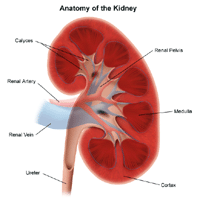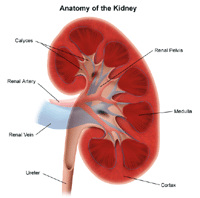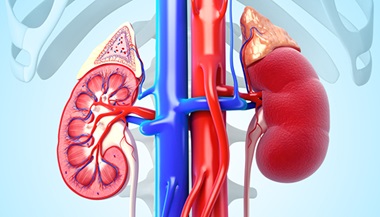Pheochromocytoma: An Adrenal Gland Tumor
What is a pheochromocytoma?
A pheochromocytoma is a rare type of tumor. It grows in the middle of an adrenal gland. Your body has two adrenal glands, one on top of each kidney. Each layer of these glands makes different hormones. The middle part of the adrenal glands makes epinephrine and norepinephrine. These hormones help keep your heart rate and blood pressure normal. A pheochromocytoma causes the adrenal glands to make too much of these hormones.
What causes pheochromocytoma?
It’s not known what causes this type of tumor. But if someone in your family has this type of tumor, you are more likely to have it.
Who is at risk for pheochromocytoma?
Pheochromocytomas happen equally in men and women. They often show up when you are in your 30s, 40s, or 50s.
If someone in your family has this type of tumor, you are more likely to have it. This tumor does not seem to be affected by environment, diet, or lifestyle. If you have this tumor, you should consider genetic testing. About 30% of these types of tumors are now believed to run in families.
What are the symptoms of pheochromocytoma?
The most common sign of a pheochromocytoma is high blood pressure. It can be always high or sometimes high. Sometimes the tumor can cause high blood pressure that can be life threatening. It is a very rare cause of high blood pressure. But it must be considered when medicine is not enough to control high blood pressure.
Other symptoms are less common. They can be brought on when you are under stress or when you change positions. Each person’s symptoms may vary. Symptoms may include:
-
Very fast pulse
-
Feeling that your heart is beating fast or fluttering (palpitations)
-
Pounding heartbeat
-
Headache
-
Nausea
-
Vomiting
-
Clammy skin
-
Shaking (tremors)
-
Anxiety
The symptoms of a pheochromocytoma may seem like other health problems. Always see your healthcare provider for a diagnosis.
How is pheochromocytoma diagnosed?
Your healthcare provider will take your medical history and give you a physical exam. You may also need tests such as:
-
Blood and urine tests. These tests measure hormone levels.
-
CT scan. This test uses X-rays and computer technology to take detailed images of your body.
-
MRI. This test uses large magnets, radio waves, and a computer to make images of organs and structures within your body.
-
Radioisotope scan. This test puts radioactive substances into your body to take an image of the tumor. The substance is absorbed into tissues that make too much of the hormone epinephrine. During the scan this area lights up. This whole-body scan can show if the disease is spreading. It can show if you have disease in other parts of your body.
How is a pheochromocytoma treated?
Your healthcare provider will figure out the best treatment for you based on:
-
How old you are
-
Your overall health and medical history
-
How sick you are
-
How well you can handle specific medicines, treatments, or therapies
-
How long the condition is expected to last
-
Your opinion or preference
Treatment may include:
-
Surgery: This is the most common treatment. The surgeon may remove 1 or both adrenal glands.
-
Medicine: If you are too sick for surgery, you may take medicine. But this is rarely done. The tumor is mainly treated with surgery.
What are the complications of a pheochromocytoma?
Most of these tumors are benign. This means they are not cancer. Many will not come back after they are removed. If the tumor comes back or spreads to some other place in the body, it may be cancer. It is hard to tell a benign tumor from a cancerous one simply by looking at it.
Living with Pheochromocytoma
Most of these tumors are benign. This means they are not cancer. Many will not come back after they are removed. If the tumor comes back or spreads to some other place in the body, it may be cancer. It is hard to tell a benign tumor from a cancerous one simply by looking at it.
When should I call my healthcare provider?
Tell your healthcare provider if your symptoms come back or get worse. Also tell your provider if you have any new symptoms.
Key Points about Pheochromocytomas
-
A pheochromocytoma is a tumor in the adrenal gland. It causes the gland to make too much of the hormones epinephrine and norepinephrine.
-
This tumor usually occurs when you are in your 30s, 40s, or 50s. It happens to both men and women.
-
It’s not known what causes these tumors. But if someone in your family has this type of tumor, you are more likely to have it.
-
The most common sign of this tumor is high blood pressure.
-
Most of these tumors are not cancer. They will not come back after they are removed.





